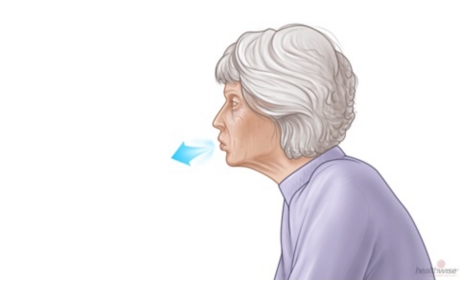Top of the pageActionset
COPD: Learning to Breathe Easier
Introduction
Chronic obstructive pulmonary disease, or COPD, is a lung disease that makes it hard to breathe. COPD gets worse over time. You can’t undo the damage to your lungs. But you can take steps to breathe easier and feel better.
- If you have severe COPD, you may find that you take quick, small, shallow breaths.
- It’s important to avoid shortness of breath. Do all you can to make breathing easier. This includes learning ways of breathing that can help the air flow in and out of your lungs.
- Breath training can help you take deeper breaths and reduce shortness of breath.
- You must practice breath training regularly to do it well.
How do you use these breathing methods?
Use these methods when you are more short of breath than normal. Practice them often so you can do them well.
Pursed-lip breathing
Pursed-lip breathing helps you breathe more air out so that your next breath can be deeper. It makes you less short of breath and lets you exercise more.
- Breathe in through your nose and out through your mouth while almost closing your lips.
- Breathe in for about 2 seconds, and breathe out for 4 to 6 seconds.
Breathing with your diaphragm
Breathing with your diaphragm helps your lungs expand so that they take in more air. Your diaphragm is the large muscle that separates your lungs from your belly.
- Lie on your back, or prop yourself up on several pillows.
- Put one hand on your belly and the other on your chest. When you breathe in, push your belly out as far as possible. You should feel the hand on your belly move out, while the hand on your chest does not move.
- When you breathe out, you should feel the hand on your belly move in. When you can do this type of breathing well while lying down, learn to do it while sitting or standing. Many people with COPD find this breathing method helpful.
- Practice this breathing method for 20 minutes at a time, 2 or 3 times a day.
Breathing while bending forward at the waist
Breathing while bending forward can reduce shortness of breath while you are exercising or resting. You can sit or stand to use this breathing method.
To use this breathing method, bend forward slightly at the waist. Keep your back straight. If you are standing, you may want to rest your hands on the edge of a table or the back of a chair.
Bending forward like this may make it easier for you to breathe. It helps your diaphragm move more easily.
Credits
Current as of: June 9, 2019
Author: Healthwise Staff
Medical Review:E. Gregory Thompson, MD – Internal Medicine & Adam Husney, MD – Family Medicine & Ken Y. Yoneda, MD – Pulmonology, Critical Care Medicine
Current as of: June 9, 2019
Author: Healthwise Staff
Medical Review:E. Gregory Thompson, MD – Internal Medicine & Adam Husney, MD – Family Medicine & Ken Y. Yoneda, MD – Pulmonology, Critical Care Medicine
This information does not replace the advice of a doctor. Healthwise, Incorporated, disclaims any warranty or liability for your use of this information. Your use of this information means that you agree to the Terms of Use. Learn how we develop our content.




